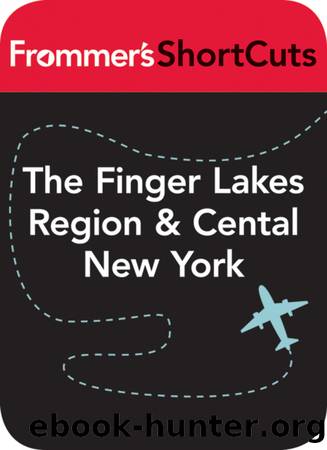The Finger Lakes Region & Central New York State by Frommer's ShortCuts

Author:Frommer's ShortCuts
Language: eng
Format: epub
Publisher: Wiley
Published: 2011-11-29T00:00:00+00:00
Seneca Falls & Northern Cayuga Lake â â
10 miles E of Geneva; 48 miles E of Syracuse; 42 miles N of Ithaca
Perched on the falls of the Seneca River and a section of the legendary Erie Canal, and cradled between the two largest of the Finger Lakes, Seneca Falls was such a quintessential American small town that Frank Capra apparently used it as the model for Bedford Falls in his classic movie Itâs a Wonderful Life. Yet the town is more significantly known for its rabble-rousing past. In the midâ19th century, Seneca Falls was home to political activists who fought for womenâs suffrage and civil rights for African Americans. The town is considered the birthplace of womenâs rights, and some women enamored of that history have moved to Seneca Falls to make it their home.
Cayuga Lake is the longest of the Finger Lakes, 42 miles from end to end.
Essentials
Getting There
By Car Seneca Falls is south of I-90 along Route 414 and equidistant on Routes 5 and 20 between Geneva and Auburn.
Visitor Information Seneca Falls Heritage Area Visitor Center, 89 Fall St. ( 315/568-2703; www.senecafalls.com), is open Monday to Saturday from 10am to 4pm and Sunday from noon to 4pm. Cayuga County Office of Tourism, 131 Genesee St., Auburn ( 800/499-9615 or 315/255-1658; www.tourcayuga.com), is open Monday to Friday from 9am to 5pm, Saturday 9am to 2pm.
Exploring Seneca Falls
The first Womenâs Rights Convention, the foundation for the modern struggle for civil rights, was held at the Wesleyan Methodist Chapel in Seneca Falls in 1848. The Womenâs Rights National Historical Park â â , 136 Fall St. ( 315/568-2991; www.nps.gov/wori), which is run by the National Park Service, commemorates the struggle initiated by Elizabeth Cady Stanton, Lucretia Mott, Susan B. Anthony, Frederick Douglass, and others (the abolitionist and womenâs rights movements were linked from early on); such happenings at Seneca Falls expanded the definition of liberty in the United States. The extant remains of the original chapel, where 300 people gathered on July 19, 1848, and the landmark âDeclaration of Sentimentsâ was drafted, is next to a museum thatâs jampacked with information about womenâs and civil rights history. The museum does an excellent job raising issues to think about for visitors of both genders and all ages, which is why itâs also a great place for kids, who can also be made âJunior Rangers.â The museum is open daily from 9am to 5pm; admission is free.
Seneca Falls has, quite understandably, become a place of pilgrimage for people with a specific interest in womenâs and civil rights. A host of related sights, including the Elizabeth Cady Stanton House, 32 Washington St. ( 315/568-2991; www.nps.gov/wori/historyculture/elizabeth-cady-stanton.htm; guided tours $1; sign up at Park Visitor Center), are located in and around Seneca Falls; pick up the booklet Womenâs Rights Trail, at the museum gift shop. Down the street from the Historical Park is the National Womenâs Hall of Fame, 76 Fall St. ( 315/568-8060; www.greatwomen.org), which is a good place to see, in name and achievement, how far women have come since the days of that legendary convention.
Download
This site does not store any files on its server. We only index and link to content provided by other sites. Please contact the content providers to delete copyright contents if any and email us, we'll remove relevant links or contents immediately.
Spare by Prince Harry The Duke of Sussex(5054)
Machine Learning at Scale with H2O by Gregory Keys | David Whiting(4115)
Fairy Tale by Stephen King(3197)
Will by Will Smith(2772)
Hooked: A Dark, Contemporary Romance (Never After Series) by Emily McIntire(2482)
The Bullet Journal Method by Ryder Carroll(2459)
Rationality by Steven Pinker(2273)
It Starts With Us (It Ends with Us #2) by Colleen Hoover(2176)
Can't Hurt Me: Master Your Mind and Defy the Odds - Clean Edition by David Goggins(2158)
Friends, Lovers, and the Big Terrible Thing by Matthew Perry(2101)
The Becoming by Nora Roberts(2064)
Love on the Brain by Ali Hazelwood(1935)
The Strength In Our Scars by Bianca Sparacino(1766)
HBR's 10 Must Reads 2022 by Harvard Business Review(1764)
A Short History of War by Jeremy Black(1745)
Leviathan Falls (The Expanse Book 9) by James S. A. Corey(1632)
515945210 by Unknown(1584)
A Game of Thrones (The Illustrated Edition) by George R. R. Martin(1564)
Bewilderment by Richard Powers(1521)
